Chapter Thirteen. Herbs that warm the Interior
 |
1. What are the functions of and indications for the herbs that warm the Interior?
Herbs that warm the Interior are able to expel Cold, rescue the Yang from collapse, warm the meridians and internal organs, and alleviate pain. They are used for internal Cold syndrome.
Internal Cold syndrome develops under two conditions. First, it is caused directly by invasion of exogenous pathogenic Cold. This invades the body through the skin and subcutaneous tissues, and then enters the meridians and internal organs. It obstructs the spreading of Yang, the movement of the Qi and the circulation of the Blood, such as is seen in Bi syndrome. In addition, if there is inappropriate consumption of cold food and drink, exogenous pathogenic Cold can directly enter the Stomach and accumulate in the Middle Jiao, such as is seen in acute gastritis, enteritis and gastric influenza. Secondly, internal Cold can develop from deficiency of the Yang of the internal organs, and especially from deficiency of the Kidney-Yang, Spleen-Yang and Heart-Yang. In most cases, the two causes coexist.
Internal Cold syndromes can be seen in the following patterns.
Accumulation of exogenous pathogenic Cold in the meridians and internal organs
Here an acute onset of the disorder appears after exposure to cold, rain or snow, or consumption of a large amount of cold drink and food. Patients may suffer from cramping pain in the limbs, abdominal pain, diarrhea, cold extremities or dysmenorrhea. There is a pallid complexion, a white tongue coating and a wiry and deep pulse.
Kidney-Yang deficiency
This syndrome can be found in elderly people and in people with a poor constitution or with chronic disease. They may suffer from cold extremities, cold in the back and cold knees, frequent urination, impotence, infertility, dysmenorrhea, aqueous-grainy diarrhea and edema. A light purple tongue body with a white and moist coating and a deep, slow and weak pulse are found in most cases. These symptoms can be seen in chronic nephritis, pyelitis and hypofunction of the pituitary gland, the adrenal cortex or the thyroid gland.
Spleen-Yang deficiency
This syndrome is often seen in people with chronic digestive disorders. They suffer from abdominal pain of a cramping nature, diarrhea or soft stools without a strong smell, edema, distension of the abdomen and a poor appetite, and have a preference for warm drinks rather than cold. A pale tongue body with a thick white coating and a weak and slow pulse are often seen. This pattern can be found in chronic colitis, peptic ulcer, chronic enteritis, liver disease, hypothyroidism and chronic nephritis.
Heart-Yang deficiency
This syndrome exists in people who are under stress or emotional distress for a long period of time. The symptoms and signs are palpitations, shortness of breath, chest pain and an oppressive sensation, cold limbs, depression, a bluish tongue body with purple spots, and a deep, wiry and irregular pulse.
Collapse of Yang
Collapse of Yang is caused by serious disturbance of the balance between Yin, Yang, Qi and Blood under the influence of pathogenic factors. When the Blood and Yin are suddenly weakened, or the Qi and Blood are suddenly obstructed, they fail to support the Yang, so the Yang collapses. This syndrome can be seen in critical conditions, especially after the collapse of Qi, such as seen in shock caused by myocardial infarction, myocarditis, severe blood loss, trauma, severe dehydration or allergy. The main symptoms are extremely cold extremities, a cold sensation that cannot be alleviated by warmth, a pallid complexion, an apathetic expression, slow reactions, shallow breathing and profuse sweating. The tongue body is pale and the pulse is thready, weak and deep.
Cold in the meridians
Both exogenous pathogenic Cold and internal Cold from Yang deficiency of the internal organs can exist in this pattern. The main symptoms are cold and severe pain in the limbs, cramp in the muscles, stiffness of the body, dysmenorrhea and cramping pain in the sides of the lower abdomen. These symptoms worsen with cold. The tongue body is bluish, its coating is white and the pulse is wiry, deep and slow.
Pain
When Cold obstructs the movement of the Qi and circulation of the Blood, it can directly cause pain which is characterized by sudden onset, cramp and a preference for warmth, such as seen in Cold Painful Obstruction syndrome, dysmenorrhea and muscle strain.
2. What are the characteristics of herbs that warm the Interior and expel Cold? What precautions should be observed in their usage?
Herbs that warm the Interior and expel Cold are able to stimulate and warm the Yang, scatter Cold, rescue the Yang from collapse, open up the meridians, promote Qi movement, invigorate the Blood circulation and alleviate pain. They have the following characteristics.
Very pungent and hot
Most of the herbs that warm the Interior are very pungent and hot. Pungency can disperse Cold, open up the meridians, and promote Qi movement and the Blood circulation. Heat can directly reduce Cold, warm the Interior and relieve cramp caused by Cold.
Entering the Heart, Spleen and Kidney meridians
The Heart-Yang, Spleen-Yang and Kidney-Yang are very important for maintaining the function of other internal organs. They stimulate Qi movement and the Blood circulation, and can promote digestion and water metabolism. Some herbs mainly warm the Yang of one of these three organs. The herbs that are used to warm the Heart-Yang are Gui Zhi ( Cinnamomi cassiae ramulus) and Rou Gui ( Cinnamomi cassiae cortex). The herbs that are often used to warm the Spleen-Yang are Gan Jiang ( Zingiberis rhizoma), Gao Liang Jiang ( Alpiniae officinari rhizoma), Wu Zhu Yu ( Evodiae fructus), Hua Jiao ( Zanthoxyli fructus) and Xiao Hui Xiang ( Foeniculi fructus). The herbs that are used for warming the Kidney-Yang are Fu Zi ( Aconiti radix lateralis preparata)* and Rou Gui.
Some herbs are very pungent and hot, their speed of scattering Cold and spreading warmth is very high, and they are considered to enter the 12 regular meridians; an example is Fu Zi.
The herbs that can expel exogenous pathogenic Cold from the superficial region of the body were detailed in the chapters on herbs that release the Exterior (Ch. 2) and herbs that expel Wind-Dampness (Ch. 5). Some of these can also be used for treating Interior Cold syndromes.
In clinical practice, herbs that warm the Interior and expel Cold should be used with caution. First, these herbs are very pungent and hot, and they can consume the Yin and Body Fluids. If used for too long or in too large a dosage, they may bring about side-effects such as dryness in the mouth, throat and nasal cavity, thirst, sore throat, constipation, itching and dry skin, a burning sensation in the Stomach and palpitations. Patients with Yin and Blood deficiency should not use them. Secondly, many patients with Blood deficiency often show symptoms of internal Cold. In this condition, herbs that warm the Interior should not be used in large amounts. Thirdly, these herbs are pungent and harsh, and are able to stimulate the Blood circulation, so should not be used in bleeding conditions or in pregnancy. However, if the bleeding causes the collapse of Yin, and further collapse of the Yang, herbs that tonify the Qi and herbs that rescue the Yang can be used together. Fourthly, in the condition of Yang collapse, herbs that rescue the Yang should be applied in time. If the Yang is extremely weak and the internal Cold exceeds its maximum, and there is a fierce conflict between the Cold pathogenic factor and the hot herbs, a small amount of cold herbs, which serves as an ‘opposing assistant’, should be added in with the larger amount of hot herbs in order to achieve the proper therapeutic result.
3. What are the differences between herbs that stimulate the Yang and those that tonify the Yang?
Herbs that stimulate the Yang and those that tonify the Yang are two different kinds of herbs, and are used in different conditions.
Herbs that stimulate the Yang
Herbs that stimulate the Yang are also called ‘herbs that warm the Interior’ or ‘herbs that expel internal Cold’. They are pungent and hot, and can directly scatter internal Cold. They are used for treating Excessive internal Cold syndromes. They can also stimulate the Yang of the internal organs, and accelerate their functions so as to disperse the internal Cold in both Excess and Deficiency conditions. The commonly used herbs are Fu Zi ( Aconiti radix lateralis preparata)*, Gan Jiang ( Zingiberis rhizoma) and Wu Zhu Yu ( Evodiae fructus). In clinical practice, the therapeutic effect of these herbs is rapid, and results in raising of the blood pressure, body temperature and heart rate, and a reduction in the reaction time of the patient. These herbs are particularly used in critical conditions, such as shock or heart or renal failure.
As these herbs are very pungent and hot, however, they can easily consume Yin and Body Fluids, so should not be used for a long period of time. In the treatment of chronic internal Cold syndromes caused by Yang deficiency, the effect of these herbs in warming the Yang and expelling Cold is neither reliable nor stable. If these herbs are used for a longer period of time, they may also consume the Yin, further damage the Yang and complicate the patient’s condition.
Herbs that tonify the Yang
Herbs that tonify the Yang are sweet and slightly warm. They can tonify the weakness of the Yang of the internal organs by replenishing the shortage of Essence. They can warm the Yang and promote its function gently. They are particularly used for treating Deficiency of the Yang in chronic diseases, especially deficiency of the Kidney-Yang. They improve the condition of patients slowly but steadily. The commonly used herbs are Du Zhong ( Eucomniae cortex), Gou Ji ( Cibotii rhizoma)**, Yi Zhi Ren ( Alpiniae oxyphyllae fructus) and Tu Si Zi ( Cuscutae semen).
In many books, herbs that stimulate the Yang and those that tonify the Yang are often called ‘herbs that warm the Yang’ or ‘herbs that strengthen the Yang’. This leads to confusion. However, there are some herbs that are pungent, hot and sweet, and have functions both of stimulating the Yang and of tonifying the Yang. These include Rou Gui ( Cinnamomi cassiae cortex), Ba Ji Tian ( Morindae radix), Yin Yang Huo ( Epimedii herba) and Gui Zhi ( Cinnamomi cassiae ramulus). They can be used in both Excess and Deficiency conditions.
In clinical practice, herbs that stimulate the Yang and herbs that tonify the Yang can be used together to treat the syndrome of Yang deficiency with internal Cold.
4. What are the commonly used strategies for warming the Interior and expelling Cold?
Herbs that warm the Interior and expel Cold are pungent and hot. They treat Excessive internal Cold syndrome. They are also often used together with tonifying herbs to treat the internal Cold syndrome caused by Yang deficiency. However, there are several different methods and strategies for warming the internal organs and meridians and expelling Cold. They are often used together in clinical practice to increase the therapeutic results of warming the Interior.
Stimulating the Yang, warming the internal organs and the meridians, and expelling Cold directly
This method is carried out by pungent and hot herbs, which are able to warm the Interior and expel Cold directly. It is used to treat Excessive internal Cold syndrome characterized by cold extremities, cramping of the muscles, stiffness of the body and severe pain. The tongue body is often bluish with a white coating, and the pulse is deep and wiry. The commonly used herbs are Fu Zi ( Aconiti radix lateralis preparata)*, Gan Jiang ( Zingiberis rhizoma), Wu Yao ( Linderae radix), Ai Ye ( Artemisiae argyi folium), Gui Zhi ( Cinnamomi cassiae ramulus) and Rou Gui ( Cinnamomi cassiae cortex).
Stimulating the Yang and tonifying the Yang
This method is particularly used for treating internal Cold syndrome caused by Yang deficiency, which is characterized by cold sensations and weakness in the back and knees, frequent urination, loose stools, edema, impotence and tinnitus. The tongue body is pale and the coating is white and moist. The pulse is deep, weak and slow. The commonly used herbs are Ba Ji Tian ( Morindae radix), Yin Yang Huo ( Epimedii herba), Rou Gui and Tu Si Zi ( Cuscutae semen).
Tonifying the Qi in order to strengthen the Yang
Since the Qi is a part of the Yang, and it can strengthen the function of internal organs, long-term deficiency of Qi may lead to deficiency of Yang. Herbs that tonify the Qi are often used when the Yang is weak and internal Cold exists. The commonly used herbs are Huang Qi ( Astragali radix) and Ren Shen ( Ginseng radix).
Promoting the movement of Qi
When internal Cold accumulates in the body, from whatever the cause, it may contract the meridians, collaterals and muscles. The Qi becomes obstructed and pain may appear in the affected area. Herbs that promote Qi movement and are warm in nature are used in these conditions to assist the herbs that expel Cold to open up the meridians and to alleviate pain. Examples are Wu Yao, Mu Xiang ( Aucklandiae radix)**, Qing Pi ( Citri reticulatae viride pericarpium) and Xiao Hui Xiang ( Foeniculi fructus).
Eliminating Cold-Dampness
When Cold accumulates in the body, no matter whether in conditions of Excess or Deficiency, it obstructs the meridians. It also obstructs the movement of Qi and the circulation of water, so that Cold-Dampness develops. Moreover, when the Yang is weak or the Cold exceeds its maximum, the Yang is not able to ‘steam’ the Yin; in consequence, the water metabolism becomes very slow and water may accumulate in certain parts of the body. In this condition, herbs that are warm in nature and that have the function of transforming Dampness should be used—for example, Cang Zhu ( Atractylodis rhizoma), Bai Zhu ( Atractylodis macrocephalae rhizoma), Sheng Jiang ( Zingiberis rhizoma recens) and Cao Dou Kou ( Alpiniae katsumadai semen).
Assisting in an opposite way to treat the syndrome of Yang collapse
When the Yang collapses, internal Cold is in excess inside the body, and it counteracts the attempts of pungent and hot herbs to enter the body because they have completely different natures. Patients may react to the conflict that ensues by vomiting up the herbal drink and they may have symptoms such as irritability, an irregular pulse and other uneasy sensations. The method of solving this problem is to add a small amount of a cold herb, such as Zhu Dan Zhi ( Pulvis bovis) or Huang Bai ( Phellodendri cortex), into a larger amount of hot herbs to moderate the conflict between the pathological cold and the hot herbs. Another method of moderating the conflict is to ask the patients to leave taking the herbal drink until it is cooler. This strategy is called ‘assisting in an opposite way’.
Applying sweet herbs to reduce the speed of the harsh herbs
To consolidate the result of warming the Interior, a good method is to use pungent and hot herbs to spread the warmth in the body, and to use sweet herbs as well to keep the pungent herb from moving too quickly. This gives a better therapeutic result. An example is the combination of Fu Zi with Zhi Gan Cao ( Glycyrrhizae radix preparata).
5. What are the differences between the functions of Fu Zi ( Aconiti radix lateralis preparata) * and Rou Gui ( Cinnamomi cassiae cortex)?
Fu Zi and Rou Gui are both pungent and hot, and both can warm the Kidney-Yang, strengthen the Kidney-Fire, scatter internal Cold and alleviate pain, but there are some differences between their functions.
Fu Zi is very pungent and hot, and it has a drying and harsh nature. Because it moves very quickly in the body, it is considered to be a herb that enters the 12 meridians. It has the quickest action in warming the Interior and expelling Cold out of all the herbs that warm the Interior. Rou Gui is less pungent and hot than Fu Zi, but it has a sweet taste and it enters only the Kidney meridian. These properties make Rou Gui especially effective for warming the Lower Jiao in order to warm the Kidney and scatter Cold there. As it is sweet, it does not move as quickly as Fu Zi. The strong point of this herb is that it spreads the warmth in a steady and strong way. It is used for severe internal Cold accumulation in the Lower Jiao, which cannot be scattered in a very short time.
Fu Zi is vigorous in warming and stimulates the Kidney-Yang, promoting the functions of the internal organs so that it can rescue the Yang from collapse; Fu Zi is considered the most important herb for treating Yang collapse. Rou Gui is not used to treat the syndrome of Yang collapse because it is not as hot and does not work as quickly as Fu Zi. However, it is able to warm and tonify the Fire of the Gate of Vitality ( Ming Men), and it is used for treating floating Yang syndrome, a syndrome that appears when the Kidney-Yang is extremely weak and internal Cold in the Lower Jiao is at its maximum. In this situation, the Cold pushes the Yang to go upwards, and the manifestations are a flushed face, a floating red color that appears only on the cheeks, heavy sweating, weak and cold limbs, a pale or light purple tongue body with a moist coating, and a weak and rootless pulse. This floating Yang syndrome is a dangerous situation like collapse of Yang. Rou Gui can warm and strengthen the Fire of the Gate of Vitality and it can disperse Cold; therefore it is able to lead the floating Fire back to its source.
Fu Zi can spread warmth quickly through the whole body through the 12 regular meridians, and scatter Cold and Dampness in the body like the sun disperses fog. This is the reason that it is a very commonly used herb to treat Bi syndrome which is caused by Cold, Dampness and Wind. Rou Gui stays in the Lower Jiao and spreads warmth there. It especially warms the Kidney meridian and treats impotence, infertility, amenorrhea and urination disorders.
Both of these two herbs can alleviate pain. Fu Zi can spread warmth, scatter Cold, dry Dampness and open up the meridians. It has very good results in alleviating pain no matter where it is. Rou Gui warms the Kidney and the Blood, scatters Cold and stimulates the Blood circulation to alleviate pain, especially when the pain is in the abdomen, back and knees.
Because of these characteristics, Fu Zi and Rou Gui are often used together in clinical practice to enhance the actions of warming and strengthening the Kidney-Yang, warming the meridians and alleviating pain.
6. What are the differences between Fu Zi ( Aconiti radix lateralis preparata)* and Gan Jiang ( Zingiberis rhizoma)?
Fu Zi and Gan Jiang are both very pungent and hot. Both of them move quickly and can scatter internal Cold, spread warmth and alleviate pain. They are often used together in acute or chronic disorders, such as in Yang Collapsing syndrome and chronic Bi syndrome. There are some differences between these two herbs, however.
Fu Zi enters the 12 meridians, but especially the Kidney meridian. It can strongly warm and strengthen the Kidney-Yang, and rescue the Yang from collapse. Gan Jiang enters primarily the Spleen meridian and it cannot directly warm the Kidney-Yang. However, it can warm the Middle Jiao and disperse Cold and dry Dampness there. It may accentuate the function of Fu Zi in warming the Kidney and rescuing the Yang. Because of this, these two herbs have become the most commonly used combination for treating Yang Collapsing syndrome.
7. What are the differences between Sheng Jiang ( Zingiberis rhizoma recens), Gan Jiang ( Zingiberis rhizoma) and Pao Jiang (quick-fried Zingiberis rhizoma preparatum)?
Sheng Jiang, Gan Jiang and Pao Jiang come from the same part of the plant. All are warm in nature and work on disorders in the Middle Jiao, but they have different characteristics.
Sheng Jiang, the fresh ginger root, is pungent and slightly warm. It primarily enters the Stomach meridian, moves without any tendency to stay, and is able to disperse Damp-Cold and to direct the Stomach-Qi downwards. It treats mainly acute stomach-ache, vomiting and nausea. Since it can also expel exterior Wind and Cold, it is especially suitable for treating acute gastritis, gastric influenza and cold infections.
Gan Jiang, the dried ginger root, is more pungent and hotter than the fresh one, and it primarily enters the Spleen meridian. It can either move or stay in the organ and meridian. It disperses Cold, dries Dampness and treats abdominal pain with a cold and cramping nature, diarrhea and poor appetite, such as seen in chronic colitis, dysentery and nephritis.
Unlike Sheng Jiang and Gan Jiang, Pao Jiang (quick-fried ginger) is not pungent and hot, but bitter and warm. It enters the Spleen meridian. Since it is not pungent, it has more of a staying tendency in its action. It particularly warms the Middle Jiao, and stops bleeding and diarrhea caused by internal Cold, such as seen in chronic colitis, dysentery, dysmenorrhea and polymenorrhea.
These three herbs are often introduced by comparisons such as: ‘S heng Jiang is rather moving than staying, Gan Jiang is either moving or staying, and Pao Jiang is rather staying than moving.’
8. What are the differences between Fu Zi ( Aconiti radix lateralis preparata)* and Wu Tou ( Aconiti radix)*
Fu Zi and Wu Tou are the roots of the same plant. They are very pungent, hot and poisonous. Both can warm the Interior and expel Cold. The main difference between their functions is that Fu Zi, the lateral root of the plant, is able to warm and strengthen the Kidney-Yang and rescue the Yang from collapse. The thin and long root is considered to have a stronger and quicker action and is used in critical situations. Wu Tou, the main root of the plant, does not have the function of strengthening the Kidney-Yang and is not able to rescue the Yang from collapse; however, it has a stronger ability than Fu Zi to expel Wind and Cold, and can strongly warm the meridians and alleviate pain.
Fu Zi and Wu Tou are both used for Bi syndrome, and their slight difference is described as: ‘ Fu Zi particularly expels Cold, and Wu Tou particularly expels Wind.’
9. What are the differences between Rou Gui ( Cinnamomi cassiae cortex) and Gui Zhi ( Cinnamomi cassiae ramulus)?
Rou Gui and Gui Zhi are different parts of the same tree. They are pungent, sweet and hot. They enter the Blood and warm it. They can also warm the meridians and alleviate pain, but there are some differences between their functions.
Rou Gui is the bark; it enters the Kidney meridian only, and its action focuses on the Lower Jiao. It is able to expel Cold and warm the Kidney and Liver meridians. It is used to treat Kidney-Yang deficiency, manifesting as cold and weakness in the back and knees, impotence, infertility, amenorrhea, dysmenorrhea, diarrhea and frequent urination.
Gui Zhi is the twig of the tree; it enters the Heart meridian primarily. Compared with Rou Gui, it is less hot and pungent, but the young twig has an aromatic smell that gives this herb a thin pungent property, which makes it move quickly and lightly. It can particularly warm the Blood, stimulate the Heart and promote the Blood circulation; therefore it can treat cold hands and feet, cramping of the muscles and pain due to Cold obstruction in the Blood circulation.
In comparing the ability of these two herbs to expel Cold and warm the Interior, Gui Zhi is more active and mainly works on the periphery, whereas Rou Gui stays in the Lower Jiao and warms the base of the body. Both can alleviate pain and are used in Bi syndrome: Rou Gui is mainly used for chronic and severe pain due to Kidney-Yang deficiency; Gui Zhi is mainly used for pain due to obstruction of the Blood circulation by Cold in the meridians. In addition, Gui Zhi also enters the Lung and Bladder meridians. As it is able to expel Wind and Cold in the superficial layer, it can treat Exterior syndrome. On the other hand, as Rou Gui can strengthen the Fire of the Gate of Vitality and lead the Fire back to its source, it is used for floating Yang syndrome.
10. What are the differences between Wu Zhu Yu ( Evodiae fructus), Gan Jiang ( Zingiberis rhizoma) and Fu Zi ( Aconiti radix lateralis preparata) * in the function of expelling interior Cold?
These three herbs are all very pungent and hot. All move quickly and have no tendency to stay. They can scatter Cold quickly and warm the Interior, but their functions have different characteristics.
Fu Zi enters the Kidney meridian primarily. It warms the Interior and can disperse Cold caused by the Kidney-Yang deficiency. Gan Jiang enters the Spleen meridian and warms the Middle Jiao; it is used in Excessive-Cold and Deficient-Cold syndromes of the Middle Jiao. Wu Zhu Yu enters and warms the Liver meridian. It directs the Liver-Qi to descend and treats its uprising caused by Excessive-Cold in the Liver meridian. As it can also spread the Liver-Qi, it can be used when the Liver-Qi attacks the Stomach. The indications for using Wu Zhu Yu are: headache, particularly on the top of the head, cramping pain with cold sensations in the Stomach or in the sides of the lower abdomen, vomiting of clear fluid, and a wiry and slow pulse. This pattern can be found in disorders such as migraine, hypertension, peptic ulcer, chronic gastritis and dysmenorrhea.
11. What are the differences between Rou Gui ( Cinnamomi cassiae cortex) and Ai Ye ( Artemisiae argyi folium) in the function of warming the Qi and Blood in the Lower Jiao?
Rou Gui and Ai Ye are warm in nature and both enter the Lower Jiao. They can warm the Qi and Blood and expel Cold, and treat dysmenorrhea, infertility and abdominal pain. However, there are some differences between their functions.
Rou Gui is very pungent and hot. It is able to warm the Blood and activate its circulation. However, it is not suitable for bleeding conditions, or for pregnant women, even when there is cold in the Lower Jiao. Ai Ye is gentler in both taste and temperature. It can warm the Liver, Kidney and Spleen meridians, and is especially suitable for regulating the menstruation and stopping bleeding caused by Cold in the Lower Jiao. It can be used for miscarriage, polymenorrhea and dysmenorrhea. It is considered an important herb for gynecological and obstetric disorders.
12. What are the differences between Ai Ye ( Artemisiae argyi folium) and Pao Jiang (quick-fried Zingiberis rhizoma preparatum) in the function of warming the meridians and stopping bleeding?
Ai Ye and Pao Jiang are pungent and warm. Both can warm the Qi and Blood, expel Cold from the meridians and stop bleeding. However, Ai Ye enters the Lower Jiao and the Liver and Kidney meridians. It warms the Blood and stops bleeding caused by Yang deficiency in the Lower Jiao. It is often used for profuse menstrual bleeding, functional uterine bleeding and bleeding during pregnancy.
Pao Jiang is bitter and warm. It enters the Middle Jiao and the Spleen meridian. It particularly warms the Middle Jiao and stops bleeding caused by Yang deficiency of the Spleen, such as seen in peptic ulcer, chronic colitis and dysentery.
13. What are the differences between Sheng Jiang ( Zingiberis rhizoma recens) and Gao Liang Jiang ( Alpiniae officinari rhizoma) in the function of warming the Stomach?
Sheng Jiang and Gao Liang Jiang are pungent and warm. Both enter the Stomach meridian and are able to expel Cold and warm the Stomach. However, Sheng Jiang is more pungent than warm; it regulates the Qi, disperses Dampness and soothes the Stomach-Qi. It treats cold sensations in the Stomach, nausea and vomiting, such as seen in cold or influenza infections.
Gao Liang Jiang is hotter and more pungent than Shen Jiang. As its heat is greater than its pungency, its action is stronger in warming the Stomach and alleviating pain. It can be used for cramping pain in the upper abdomen, vomiting of clear fluid and preference for warm drinks. These disorders can be seen in chronic gastritis and gastroduodenal ulcer.
14. Xiao Hui Xiang ( Foeniculi fructus), Cao Dou Kou ( Alpiniae katsumadai semen), Hua Jiao ( Zanthoxyli fructus) and Ding Xiang ( Caryophylli flos) all can warm the Middle Jiao and expel Damp-Cold. What are the differences between their functions?
These four herbs are pungent and warm, and enter the Spleen and Stomach meridians. They can warm the Middle Jiao and expel Cold and Dampness. They are used to treat abdominal pain, distension, poor appetite, vomiting and diarrhea. However, they have different characteristics.
Xiao Hui Xiang is an aromatic herb that can disperse Cold and promote Qi movement; therefore it is able to alleviate pain and improve the appetite. Cao Dou Kou is also an aromatic herb; unlike Xiao Hui Xiang, which promotes Qi movement, its strong point is drying Dampness and warming the Spleen. Because of this, it can treat nausea, vomiting, diarrhea and poor appetite. Hua Jiao has similar functions to Cao Dou Kou, but it is much warmer, so its action in drying Dampness and dispersing Cold is stronger than that of Cao Dou Kou. Since it is a poisonous herb and it moves quickly in the Middle Jiao, it is used only for acute Excessive Damp-Cold syndrome for a short therapeutic duration, such as for severe pain and cramping in the abdomen, frequent and urgent bowel movement and watery stools. Ding Xiang, like Xiao Hui Xiang, can regulate the Qi, but it is especially able to descend the Stomach-Qi and treat belching and hiccups.
Besides warming the Middle Jiao, Xiao Hui Xiao can also promote the Qi movement in the Lower Jiao. It enters the Kidney and Liver meridians, and treats abdominal pain, distension and cramping in the sides of the lower abdomen and hernia. Hua Jiao and Ding Xiang are able to warm the Kidney-Yang and treat Cold in the lower back and abdomen, diarrhea, impotence and cold extremities.
15. Which herbs can soothe the Stomach-Qi and treat vomiting? What are their characteristics?
The commonly used herbs to soothe the Stomach-Qi and stop vomiting are Ban Xia ( Pinelliae rhizoma), Zi Su Ye ( Perillae folium), Sheng Jiang ( Zingiberis rhizoma recens), Gao Liang Jiang ( Alpiniae officinari rhizoma), Wu Zhu Yu ( Evodiae fructus), Hua Jiao ( Zanthoxyli fructus), Cao Dou Kou ( Alpiniae katsumadai semen), Xiao Hui Xiang ( Foeniculi fructus), Ding Xiang ( Caryophylli flos), Huang Qin ( Scutellariae radix), Huang Lian ( Coptidis rhizoma) and Zhu Ru ( Bambusae caulis in taeniam).
The characteristics of these herbs can be summarized briefly as follows:
• Ban Xia especially treats nausea when there is Phlegm in the Stomach and Lung
• Zi Su Ye and Sheng Jiang treat vomiting in Exterior syndrome
• Gao Liang Jiang can warm the Stomach strongly, stop vomiting and relieve pain
• Wu Zhu Yu treats vomiting of clear fluid when there is severe headache in the top of the head
• Hua Jiao, Cao Dou Kou and Xiao Hui Xiang are able to warm the Spleen, and to regulate the Qi in the Middle Jiao in order to regulate the Stomach-Qi and stop vomiting
• Ding Xiang can descend the Stomach-Qi and treat belching and hiccup
• Huang Qin, Huang Lian and Zhu Ru are cold in nature and are used for vomiting caused by Heat or Phlegm-Heat in the Stomach.
Comparisons of strength and temperature in herbs that warm the Interior
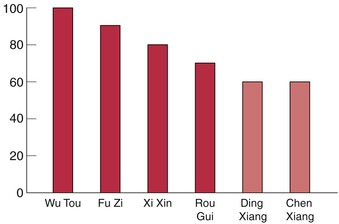 |
| Fig. 13.1. |
| Comparison of the herbs that expel Cold and warm the Kidney. Wu Tou ( Aconiti radix)*, Fu Zi ( Aconiti radix lateralis preparata)*, Xi Xin ( Asari herba)*, Rou Gui ( Cinnamomi cassiae cortex), Ding Xiang ( Caryophylli flos), Chen Xiang ( Aquilariae lignum) . |
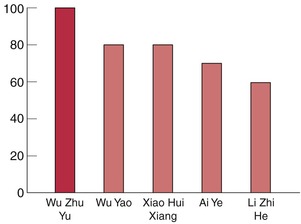 |
| Fig. 13.2. |
| Comparison of the herbs that expel Cold and warm the Liver. Wu Zhu Yu ( Evodiae fructus), Wu Yao ( Linderae radix), Xiao Hui Xiang ( Foeniculi fructus), Ai Ye ( Artemisiae argyi folium), Li Zhi He ( Litchi semen). |
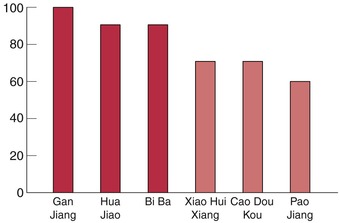 |
| Fig. 13.3. |
| Comparison of the herbs that expel Cold and warm the Spleen. Gan Jiang ( Zingiberis rhizoma), Hua Jiao ( Zanthoxyli fructus), Bi Ba ( Piperis longi fructus), Xiao Hui Xiang ( Foeniculi fructus), Cao Dou Kou ( Alpiniae katsumadai semen), Pao Jiang (quick-fried Zingiberis rhizoma preparatum) . |
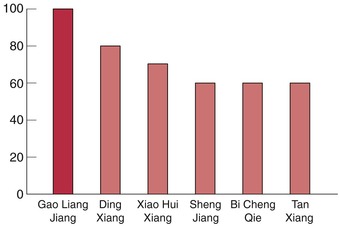 |
| Fig. 13.4. |
| Comparison of the herbs that expel Cold and warm the Stomach. Gao Liang Jiang ( Alpiniae officinari rhizoma), Ding Xiang ( Caryophylli flos), Xiao Hui Xiang ( Foeniculi fructus), Sheng Jiang ( Zingiberis rhizoma recens), Bi Cheng Qie ( Litseae fructus), Tan Xiang ( Santali albi lignum). |
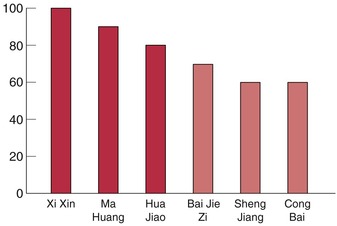 |
| Fig. 13.5. |
| Comparison of the herbs that expel Cold and warm the Lung. Xi Xin ( Asari herba)*, Ma Huang ( Ephedrae herba)*, Hua Jiao ( Zanthoxyli fructus), Bai Jie Zi ( Sinapis albae semen), Sheng Jiang ( Zingiberis rhizoma recens), Cong Bai ( Allii fistulosi bulbus). |
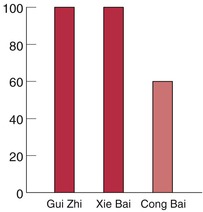 |
| Fig. 13.6. |
| Comparison of the herbs that expel Cold and warm the Heart. Gui Zhi ( Cinnamomi cassiae ramulus), Xie Bai ( Allii macrostemi bulbus), Cong Bai ( Allii fistulosi bulbus). |






